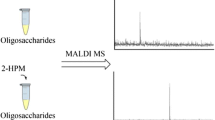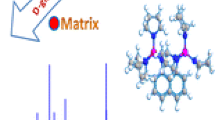Abstract
The atmospheric pressure matrix-assisted laser desorption/ionization (AP-MALDI) is a quite convenient soft ionization for biomolecules, keeping analytes atmospheric conditions instead of high vacuum conditions. In this study, an AP-MALDI ion source has been coupled to a quadrupole ion trap time-of-flight (QIT-TOF) mass spectrometer, which is able to perform MSn analysis. We applied this system to the structural characterization of monosialogangliosides, GM1 (NeuAc) and GM2 (NeuAc), disialogangliosides, GD2 (NeuAc, NeuAc), GD1a (NeuAc, NeuAc) and GD1b (NeuAc, NeuAc) and trisialoganglioside GT1a (NeuAc, NeuAc, NeuAc). In this system, the negative ion mass spectra of MS, MS2 and MS3, a set of three mass spectra, were able to measure within 2 s per cycle. Thus, obtained results demonstrate that the negative ion mode MS, MS2 and MS3 spectra provided sufficient information for the determination of molecular weights, oligosaccharide sequences and ceramide structures, and indicate that the AP-MALDI-QIT-TOF mass spectrometry keeping analytes atmospheric conditions with MSn switching is quite useful and convenient for structural analyses of various types of sialic acid-containing GSLs, gangliosides.







Similar content being viewed by others
Abbreviations
- AP:
-
Atmospheric pressure
- MALDI:
-
Matrix-assisted laser desorption/ionization
- QIT-TOF MS:
-
Quadrupole ion trap time-of-flight mass spectrometry
- GSLs:
-
Glycosphingolipids
References
Hakomori S, Igarashi Y (1995) Functional role of glycosphingolipids in cell recognition and signaling. J Biochem 118:1091–1103
Karlsson KA (1998) On the character and functions of sphingolipids. Acta Biochim Pol 45:429–438
Maccioni HJ, Quiroga R, Ferrari ML (2011) Cellular and molecular biology of glycosphingolipid glycosylation. J Neurochem 117:589–602
Haughey NJ (2010) Sphingolipids in neurodegeneration. Neuromol Med 12:301–305
Ledeen R, Wu G (2011) New findings on nuclear gangliosides: overview on metabolism and function. J Neurochem 116:714–720
Dreyfus H, Meuillet E, Guerold B, Fontaine V, Forster V, Heidinger V, Sahel J, Hicks D (1997) Ganglioside and neurotrophic growth factor interactions in retinal neuronal and glial cells. Ind J Biochem Biophys 34:90–96
Chiavegatto S, Sun J, Nelson RJ, Schnaar RL (2000) A functional role for complex gangliosides: motor deficits in GM2/GD2 synthase knockout mice. Exp Neurol 166:227–234
Rosner H (2003) Developmental expression and possible roles of gangliosides in brain development. Prog Mol Subcell Boil 32:49–73
Skaper SD, Leon A, Toffano G (1989) Ganglioside function in the development and repair of the nervous system. From basic science to clinical application. Mol Neurobiol 3:173–199
Martin MJ, Martin-Sosa S, Alonso JM, Hueso P (2003) Enterotoxigenic Escherichia coli strains bind bovine milk gangliosides in a ceramide-dependent process. Lipid 38:761–768
Ponnusamy S, Meyers-Needham M, Senkal CE, Saddoughi SA, Sentelle D, Selvam SP, Salas A, Ogretmen B (2010) Sphingolipids and cancer: ceramide and sphingosine-1-phosphate in the regulation of cell death and drug resistance. Future Oncol 6:1603–1624
Gault CR, Obeid LM, Hannun YA (2010) An overview of sphingolipid metabolism: from synthesis to breakdown. Adv Exp Med Biol 688:1–23
Yang J, Yu Y, Sun S, Duerksen-Hughes PJ (2004) Ceramide and other sphingolipids in cellular responses. Cell Biochem Biophys 40:323–350
Ruvolo PP (2003) Intracellular signal transduction pathways activated by ceramide and its metabolites. Pharmacol Res 47:383–392
Levery SB (2005) Glycosphingolipid structural analysis and glycosphingolipidomics. Methods Enzymol 405:300–369
Tanaka K, Ojima N, Yamada M (2004) A new approach to post-translational modification analyses using MALDI-QIT-TOF MS. Tanpakushitsu Kakusan Koso 49:1907–1910
Yamada K, Kinoshita M, Hayakawa T, Nakaya S, Kakehi K (2009) Comparative studies on the structural features of O-glycans between leukemia and epithelial cell lines. J Proteome Res 8:521–537
Laiko VV, Moyer SC, Cotter RJ (2000) Atmospheric pressure MALDI/ion trap mass spectrometry. Anal Chem 72:5239–5243
Moyer SC, Cotter RJ, Woods AS (2002) Fragmentation of phosphopeptides by atmospheric pressure MALDI and ESI/Ion trap mass spectrometry. J Am Soc Mass Spectrom 13:274–283
Tan PV, Laiko VV, Doroshenko VM (2004) Atmospheric pressure MALDI with pulsed dynamic focusing for high-efficiency transmission of ions into a mass spectrometer. Anal Chem 76:2462–2469
Schulz E, Karas M, Rosu F, Gabelica V (2006) Influence of the matrix on analyte fragmentation in atmospheric pressure MALDI. J Am Soc Mass Spectrom 17:1005–1013
Navare A, Nouzova M, Noriega FG, Hernández-Martínez S, Menzel C, Fernández FM (2009) On-chip solid-phase extraction pre-concentration/focusing substrates coupled to atmospheric pressure matrix-assisted laser desorption/ionization ion trap mass spectrometry for high sensitivity biomolecule analysis. Rapid Commun Mass Spectrom 23:477–486
Suzuki M, Yamakawa T, Suzuki A (1990) High-performance liquid chromatography-mass spectrometry of glycosphingolipids: II. Application to neutral glycolipids and monosialogangliosides. J Biochem 108:92–98
Ann Q, Adams J (1992) Structure determination of ceramides and neutral glycosphingolipids by collisional activation of [M+Lil]+ ions. J Am Soc Mass Spectrom 3:260–263
Ann Q, Adams J (1993) structure-specific collision-induced fragmentations of ceramides cationized with alkali-metal ions. Anal Chem 65:7–13
Lee MH, Lee GH, Yoo JS (2003) Analysis of ceramides in cosmetics by reversed-phase liquid chromatography/electrospray ionization mass spectrometry with collision-induced dissociation. Rapid Commun Mass Spectrom 17:64–75
Zarei M, Bindila L, Souady J, Dreisewerd K, Berkenkamp S, Müthing J, Peter-Katalinić J (2008) A sialylation study of mouse brain gangliosides by MALDI a-TOF and o-TOF mass spectrometry. J Mass Spectrom 43:716–725
Sugiura Y, Shimma S, Konishi Y, Yamada MK, Setou M (2008) Imaging mass spectrometry technology and application on ganglioside study; visualization of age-dependent accumulation of C20-ganglioside molecular species in the mouse hippocampus. PLoS ONE 3:e3232
Laiko VV, Baldwin MA, Burlingame AL (2000) Atmospheric pressure MALDI/ion trap mass spectrometry. Anal Chem 72:652–657
Ikeda K, Taguchi R (2010) Highly sensitive localization analysis of gangliosides and sulfatides including structural isomers in mouse cerebellum sections by combination of laser microdissection and hydrophilic interaction liquid chromatography/electrospray ionization mass spectrometry with theoretically expanded multiple reaction monitoring. Rapid Commun Mass Spectrom 24:2957–2965
Ikeda K, Shimizu T, Taguchi R (2008) Targeted analysis of ganglioside and sulfatide molecular species by LC/ESI-MS/MS with theoretically expanded multiple reaction monitoring. J Lipid Res 49:2678–2689
Nakamura K, Suzuki Y, Goto-Inoue N, Yoshida-Noro C, Suzuki A (2006) Structural characterization of neutral glycosphingolipids by thin-layer chromatography coupled to matrix-assisted laser desorption/ionization quadrupole ion trap time-of-flight MS/MS. Anal Chem 78:5736–5748
Sugiyama E, Hara A, Uemura K, Taketomi T (1997) Application of matrix-assisted laser desorption ionization time-of-flight mass spectrometry with delayed ion extraction to ganglioside analyses. Glycobiology 7:719–724
Mechref Y, Novotny MV (1998) Matrix-assisted laser desorption/ionization mass spectrometry of acidic glycoconjugates facilitated by the use of spermine as a co-matrix. J Am Soc Mass Spectrom 9:1293–1302
Jackson SN, Wang HY, Woods AS (2005) Direct profiling of lipid distribution in brain tissue using MALDI-TOFMS. Anal Chem 77:4523–4527
Tajiri M, Takeuchi T, Wada Y (2009) Distinct features of matrix-assisted 6 micron infrared laser desorption/ionization mass spectrometry in biomolecular analysis. Anal Chem 81:6750–6755
Ivleva VB, Sapp LM, O’Connor PB, Costello CE (2005) Ganglioside analysis by thin-layer chromatography matrix-assisted laser desorption/ionization orthogonal time-of-flight mass spectrometry. J Am Soc Mass Spectrom 16:1552–1560
Mahfoud R, Manis A, Binnington B, Ackerley C, Lingwood CA (2010) A major fraction of glycosphingolipids in model and cellular cholesterol-containing membranes is undetectable by their binding proteins. J Biol Chem 285:36049–36059
Togayachi A, Kozono Y, Ikehara Y, Ito H, Suzuki N, Tsunoda Y, Abe S, Sato T, Nakamura K, Suzuki M, Goda HM, Ito M, Kudo T, Takahashi S, Narimatsu H (2010) Lack of lacto/neolacto-glycolipids enhances the formation of glycolipid-enriched microdomains, facilitating B cell activation. Proc Natl Acad Sci USA 107:11900–11905
Acknowledgments
This work was supported by a grant for Supporting Research Centers in Private Universities and by Grant-in-Aid for Scientific Research (A).
Author information
Authors and Affiliations
Corresponding author
Additional information
Special Issue: In honor of Bob Leedeen.
Rights and permissions
About this article
Cite this article
Ito, E., Tominaga, A., Waki, H. et al. Structural Characterization of Monosialo-, Disialo- and Trisialo-gangliosides by Negative Ion AP-MALDI-QIT-TOF Mass Spectrometry with MSn Switching. Neurochem Res 37, 1315–1324 (2012). https://doi.org/10.1007/s11064-012-0735-z
Received:
Revised:
Accepted:
Published:
Issue Date:
DOI: https://doi.org/10.1007/s11064-012-0735-z




